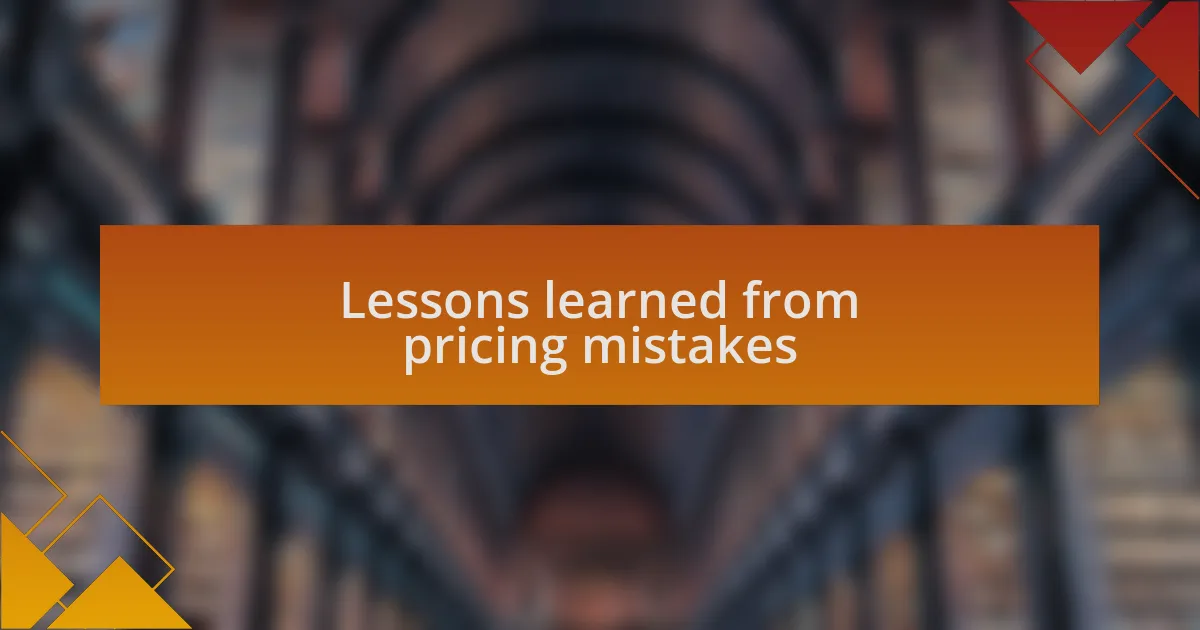Key takeaways:
- Pricing in publishing requires a balance between costs, perceived value, and market trends, with emotional connections influencing buyer perceptions.
- Producing competitive pricing strategies involves thorough market research, customer feedback, and responsiveness to trends and seasonal fluctuations.
- Setting prices should reflect not only production costs but also the uniqueness and craftsmanship of the products while maintaining affordability through tiered options.
- Regularly reviewing and adjusting pricing strategies based on market changes and customer insights is crucial for long-term success in the industry.

Understanding pricing in publishing
Pricing in publishing can often feel like a tightrope walk. I’ve found that balancing costs, perceived value, and market trends is crucial. Have you ever considered how your target audience reacts to price changes? It’s fascinating how a small adjustment can shift their perception of quality and worth.
When I first started pricing my print-on-demand (POD) items, I faced confusion and uncertainty. I remember questioning whether I was undervaluing my work or pricing it too high to attract buyers. After some trial and error, I learned that research is invaluable; exploring competitors and their pricing structures helped clarify my strategy.
One powerful insight I’ve gained is the emotional connection buyers have with price. Pricing isn’t just a figure; it’s tied to their experience and perception of my brand’s value. For instance, I noticed that by slightly increasing the price on certain exclusive items, customers perceived them as more premium. Have you felt that buzz when customers appreciate the uniqueness of your offerings? It reinforces the idea that pricing isn’t merely a number but a critical part of your storytelling in publishing.

Factors influencing pricing decisions
One significant factor that influences my pricing decisions is the cost of production. When I calculate expenses, I account for materials, printing, and shipping. When I saw how these costs stacked up with my POD items, it made me realize that I needed to charge enough to cover not just my direct expenses but also to sustain my business in the long run. Have you ever felt the pressure between wanting to keep prices low for customers and ensuring you aren’t sacrificing your livelihood?
Market trends also play a vital role in shaping my pricing strategy. I track popular items and shifts in demand, and it’s eye-opening to see how quickly preferences can change. For instance, after releasing a new design that resonated with my audience, I adjusted the price upward based on the increased interest. It’s a bit of a gamble, but that instinct to capitalize on trends has often paid off. Have you ever adjusted prices on the fly based on what’s hot in your niche?
Finally, customer feedback can be a game changer in my pricing journey. When I launched a limited edition item at a higher price, I was hesitant. However, the positive responses I received made me realize that my audience appreciated the added value. It taught me that sometimes, customers are willing to pay more for what they perceive as special. How often do you check in with your customers to understand their views on pricing? Their insights can guide your decisions and enhance your connection with them.

Researching the market value
When I set out to research the market value of my POD items, I often find myself diving deep into competitor pricing. I remember my first experience, where I spent hours analyzing similar products on various platforms. It was fascinating to see the range of prices and to pinpoint where my offerings fit within that spectrum. How do you think your items compare to others in your niche?
It’s not just about what competitors are charging; I also keep an eye on customer expectations. For example, after studying forums and social media groups related to my genre, I noticed a recurring theme: buyers are often willing to pay a premium for items that reflect quality craftsmanship. This revelation encouraged me to reassess the value I present through my designs. Have you ever had a moment where understanding customer sentiment shifted your perspective on pricing?
Lastly, seasonal trends can drastically influence perceived value. I recall a holiday season when I introduced themed items and adjusted my prices accordingly. The willingness of customers to invest in gifts during this time was much higher than expected. It underscored the importance of timing and relevance in pricing strategy. Have you tapped into seasonal trends to maximize your pricing effectively? Understanding these fluctuations can truly enhance your revenue potential.

Setting prices for POD items
Finding the right balance in pricing my POD items is often a delicate dance. For instance, there was a time when I nervously set my prices based solely on production costs, only to realize later that my work was undervalued. I learned quickly that pricing should reflect not just expenses but also the uniqueness of my designs and the time I invested. Have you wrestled with feeling your work is worth more but hesitated to raise your prices?
Another aspect I consider is the psychology of pricing. I remember launching a new collection and pricing my items with charming odd numbers—like $19.99—instead of just rounding up. It was interesting to see how this small tweak positively impacted sales. Have you ever experimented with psychological pricing to see what resonates with your audience?
Lastly, I’ve noticed the importance of being flexible with my pricing strategy. There was a specific instance where I temporarily lowered prices for a limited-time promotion, and the response was overwhelming. This experience taught me that adapting my prices can generate excitement and urgency. Have you thought about how strategic discounts could enhance your sales while still maintaining perceived value in your brand?

Balancing quality and affordability
Finding the sweet spot between quality and affordability is crucial when pricing POD items. I recall a time when I received feedback on one of my designs; despite its high quality, some potential buyers felt it was too pricey. That moment prompted me to evaluate how I could maintain my standards without alienating budget-conscious customers. Have you ever faced that uneasy feeling of compromising quality for a lower price?
As I navigated pricing strategies, I discovered that offering tiered options can effectively balance quality and affordability. For example, I created a budget-friendly version of a popular item while keeping the premium edition available for those willing to invest more. This approach not only broadened my audience but also gave customers the freedom to choose based on their own budgets. Have you explored variations in your product line to appeal to different price points?
When I reflect on the reactions from my customers when I introduced a mid-range option, I felt proud. They appreciated the choice without feeling like they were sacrificing quality. It made me realize how essential it is to communicate the value behind my creations—whether it’s the craftsmanship or the thought that goes into each piece. How do you convey the worth of your items to encourage a deeper connection with your audience?

My personal pricing strategy
When considering my pricing strategy, I’ve often relied on introspection about the value of my work. For instance, I remember a conversation with a fellow creator who felt devalued because her prices were too low. It made me rethink how I view my creations; everything I design reflects my unique perspective, and that must be reflected in the price. Have you ever felt that your work deserves more recognition than what a low price conveys?
I’ve also found that engaging directly with my customers can illuminate their perception of value. I recall sending out a survey after launching a new line of products, asking for feedback on pricing. The insights I received were enlightening; many customers expressed that they were willing to pay more for items that resonated with them on a personal level. How often do we overlook the power of customer feedback in shaping our pricing models?
Ultimately, I strive for a pricing model that feels equitable both to myself and my audience. I’ve learned that being transparent about the costs associated with production can foster trust. When I share details about where materials come from or the time it takes to create each piece, customers are often more willing to invest, understanding the backstory. Isn’t it fascinating how storytelling can elevate the perceived value of our work?

Lessons learned from pricing mistakes
One of the most significant lessons I learned emerged from an initial pricing blunder when I underestimated the production costs of my items. I remember launching a new product line and setting prices that seemed attractive. However, I quickly found that I was barely breaking even, and it made me feel frustrated and undervalued. Have you ever felt that sting when your hard work doesn’t translate into fair compensation?
Another critical insight came when I set my prices too high, hoping to project exclusivity. Initially, I thought this would position my products as premium, but sales stagnated. This experience taught me that while ambition in pricing can be enticing, understanding your audience’s willingness to pay is essential. Have you been surprised at how quickly pricing decisions can either elevate or diminish your brand’s market presence?
Finally, I learned the importance of regularly reviewing my pricing strategy. I remember a moment when I revisited older product lines, realizing that market trends had shifted, and I hadn’t adjusted accordingly. It was a humbling realization that staying current is key. This experience makes me wonder: how often do we reflect on our pricing in the fast-changing marketplace? Keeping a finger on the pulse of both production costs and customer sentiment is vital for long-term success.